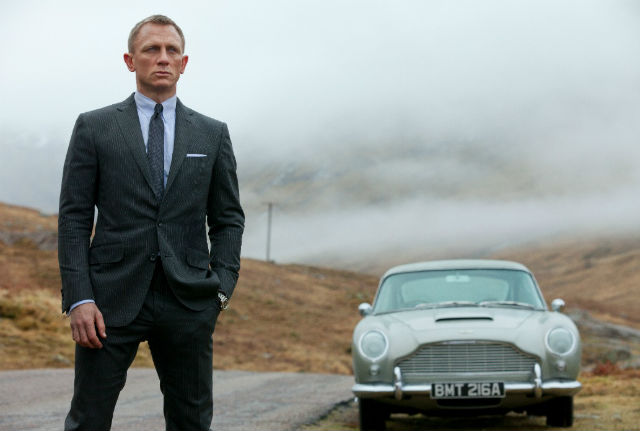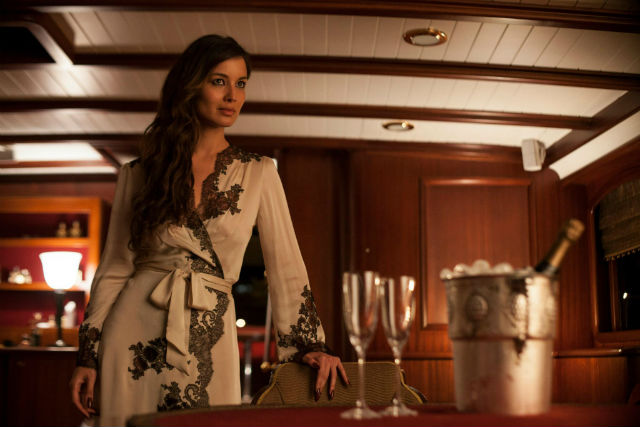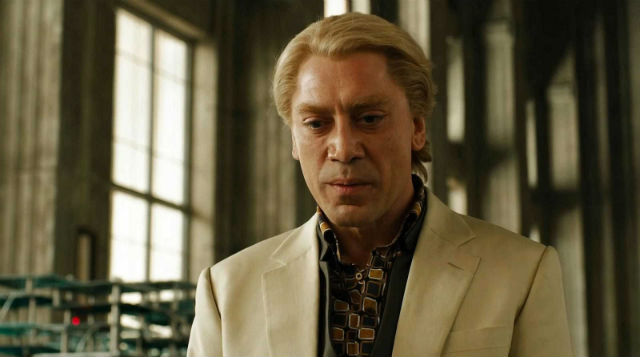Filtered By: Lifestyle
Lifestyle
Movie review: '007' franchise faces the future by returning 'Bond' to his roots
“Where are we going?” demands ‘M’, James Bond’s imperious spymaster. Coolly-detached, Bond meets her gaze in the rear-view mirror before answering, “Back to the beginning.”
Exchanges like this – one of several that could just as easily be directed at the viewer – characterize “Skyfall”, a James Bond film that wisely, if atypically (for this franchise), places characters and emotions before the prerequisite martinis (shaken, not stirred) and explosions.
As the 23rd entry in the official James Bond film canon, “Skyfall” succeeds in completing the ‘reboot’ of the character that began in 2006’s “Casino Royale”.

Daniel Craig, seen here next to 007's trademark 1964 Aston Martin DB5, continues to impress with his portrayal of Bond.
Just in time for the films’ 50th anniversary and coming after the deplorable “Jason Bourne” ersatz that was 2008’s “Quantum of Solace”, Bond fans the world over will be happy to know that their hero is back and better than ever.
Opening in Istanbul with a slam-bang chase that leads directly to a story-specific (and somewhat macabre) title sequence, “Skyfall’s” plot deals with attacks on the British Secret Service both from within and without, as M’s past comes back to haunt her.
What starts as a straightforward mission to recover a stolen list of NATO undercover operatives becomes a complete deconstruction of the franchise as Bond is confronted with the very real possibility of obsolescence due to his age, gadgets and methods. Even his single-minded devotion to Queen and Country is called into question.
At the same time, M finds herself countering administrative allegations of MI6’s irrelevance in an era of digital, rather than human, espionage.
Directed by Sam Mendes (“American Beauty”, “Road to Perdition”), the script, by Bond regulars Neal Purvis and Robert Wade, with John Logan (“Gladiator”, “The Aviator”, “Hugo”) pays self-aware tribute to what came before by checking all the required boxes for a Bond film (exotic locales, gratuitous product placement, gadgets, girls and guns), without resorting to the excessive tongue-in-cheek that marred the 40th anniversary’s “Die Another Day”.
“Skyfall’s” greatest strength lies in how it honors the franchise’s history while going boldly into territory previously unexplored, namely, Bond’s past.
Casual viewers may be stunned to find that, after five decades, there remains something left unsaid about James Bond; but “Skyfall” brilliantly proves that the old boy still has surprises up his well-tailored sleeve.
Exploding onto the scene in 1962’s “Doctor No” in the form of a radically-made-over former truck driver/coffin polisher/Mr. Universe runner-up named Sean Connery, the character of James Bond is one that was introduced to audiences fully-formed, with no screen time spent on anything resembling a back story.
Given the adult escapist tone that would become the series’ trademark, along with the trappings of Bond’s world quickly becoming ingrained on the world’s collective pop culture consciousness, there was very little – if any – clamor to know from whence this cinematic superhero came or what made him tick.
And then “Casino Royale” happened, introducing the world to Daniel Craig in magnificent style.
Where that film was a conscious effort on the part of the filmmakers to show the beginnings of Bond’s career, “Skyfall” completes the arc by exploring aspects of his family and childhood touched upon – but never elaborated on – in “On Her Majesty’s Secret Service” (1969) and “Goldeneye” (1995).
Craig, in his third outing as 007, continues to impress; his Bond is not the charming, sophisticated secret agent depicted in the first twenty films, but the hard-drinking, unapologetic “blunt instrument” of the classic novels, albeit with a hint of his predecessors’ penchant for one-liners thrown in for good measure.
This is the Bond Timothy Dalton tried to unleash on the world in 1987’s “The Living Daylights” and 1989’s “Licence to Kill” and in the process confusing audiences weaned on Sean Connery’s suave sophisticate (in six films) and Roger Moore’s proper English gentleman (in seven films).
Where Pierce Brosnan’s interpretation was a composite of his four (the less said about one-time-only Bond George Lazenby, the better) precursors’ best qualities, current 007 Craig’s nuanced portrayal is the closest we’ve ever gotten to Ian Fleming’s literary creation made flesh, a character rendered infinitely more interesting by the fact that we can relate to him.
Craig’s Bond gets hurt, feels emotions and, most shockingly, displays the physiological effects of his decadent lifestyle.
The supporting cast here may be the finest yet assembled for a Bond film: Ralph Fiennes appears as M’s superior, Gareth Mallory, an appropriately-authoritative role for the former Voldemort. Naomie Harris amuses as rookie agent Eve, a flirtatious foil for 007 – a status she will apparently be enjoying for some time yet – while Bérénice Marlohe brings bemused cynicism to her role as the ill-fated Sévérine.

Bérénice Marlohe provides eye candy as Sévérine.
The real “Bond Girl” to watch here is Judi Dench, who, in her seventh appearance as M, is given the best use of her considerable talents thus far in the series.
Albert Finney shows up as a gamekeeper with more than a passing semblance in function to Batman’s /Bruce Wayne’s Alfred.
Gadget master ‘Q’ makes a welcome return to the series, played by a wiry, bespectacled Ben Whishaw (2006’s criminally-underappreciated “Perfume”). Whishaw’s portrayal may be several decades younger than Desmond Llewelyn’s beloved quartermaster (who supplied every Bond, from Connery to Brosnan, with gadgets galore) but he proves himself no less capable (and, more importantly, credible), providing 007 with his toys while trading barbs and expressing wishful thinking that his equipment will be returned to him in one piece.
In a cast of respected thespians, Javier Bardem (“No Country for Old Men”) steals the show as the villain of the piece, cyber-terrorist Raoul Silva, who is introduced to the audience (and Bond) via long take while dispensing a cautionary parable about rats.
Deformed in spirit and flesh in a manner that would make Fleming proud, Silva wants nothing more than to take vengeance on M after having been played as the bargaining chip in a prisoner exchange.

Javier Bardem plays cyberterrorist Raoul Silva as a Bond villain for the ages.
Keeping with the film’s ongoing theme of taking everything beloved about the series and turning it on its ear, then, in a twisted reflection of M’s somewhat-maternal relationship with 007, Silva is the unwanted bastard to Bond’s favorite son. This is literally a villain unlike any other in the series’ storied history.
Suffice it to say, Bond has encountered more than his share of megalomaniacal lunatics over the past 50 years, but he’s never been manhandled quite like this.
The final section of the film is where “Skyfall” strays farthest from established territory, with the villain laying siege to Bond’s fortified sanctuary (rather than the other way around). Dirty and visceral in execution, the cartoonish violence of yesteryear is nowhere to be found.
Heavy on narrative symbolism, the Scottish sequences enable nine-time Academy Award nominated – and Coen brothers regular – cinematographer Roger Deakins to earn his pay. In a film filled with inventive shots and exceptional lighting – including one illuminated (ostensibly) entirely by LED billboards – the decidedly-gothic Scottish sequences are rendered especially, eerily, beautiful.
If “Casino Royale” was the first step in stripping away all the familiar Bond elements while finding new ways to (re)interpret and justify them, “Skyfall” is the logical (and thematic) conclusion to the reinvention.
By the end of the film, hardened by his experiences, a refocused 007 has come full circle to where he was when the series began 50 years ago, with Moneypenny in the front office – flanked by the coat rack Connery used to toss his hat onto – and a male M ensconced behind the double leather doors waiting to dispense Bond’s latest marching orders.
Everything old is new again, and we, along with Bond, are primed and ready for the next mission.
James Bond is dead. Long live 007! — ELR/KG, GMA News
Photos courtesy of Columbia Pictures
A lifelong fan of cinema and literature kept ambulatory by an ungodly mix of sugar, caffeine and adrenaline, Mikhail Lecaros is a professional magazine editor and freelance writer who's decided that he wants to be Hunter S. Thompson if and when he is forced to grow up. The views expressed in this article are solely his own.
More Videos
Most Popular




